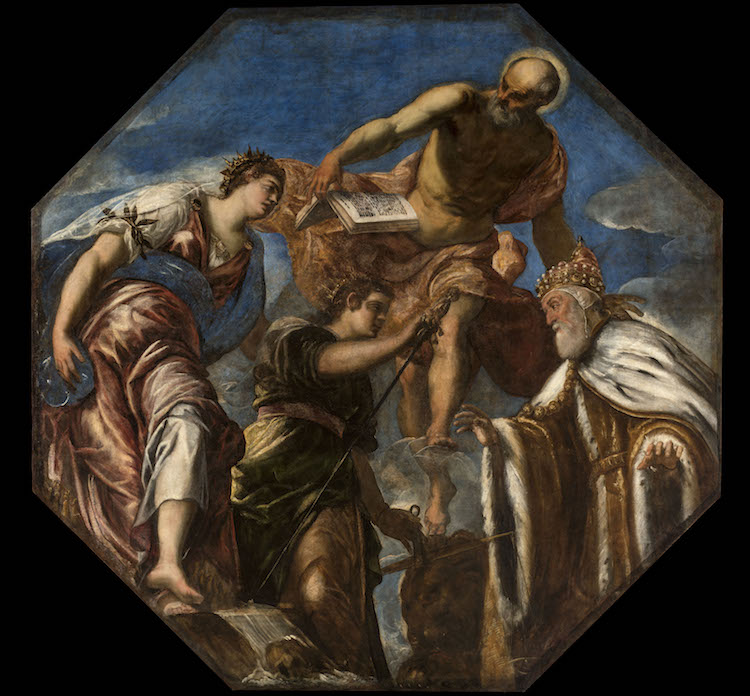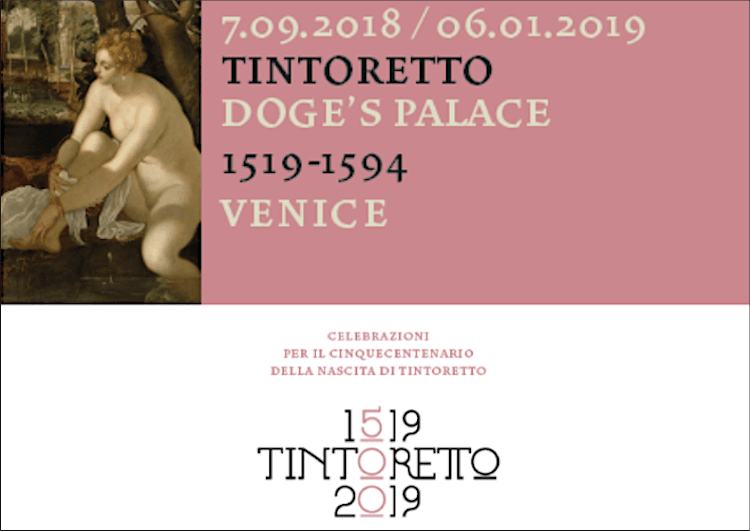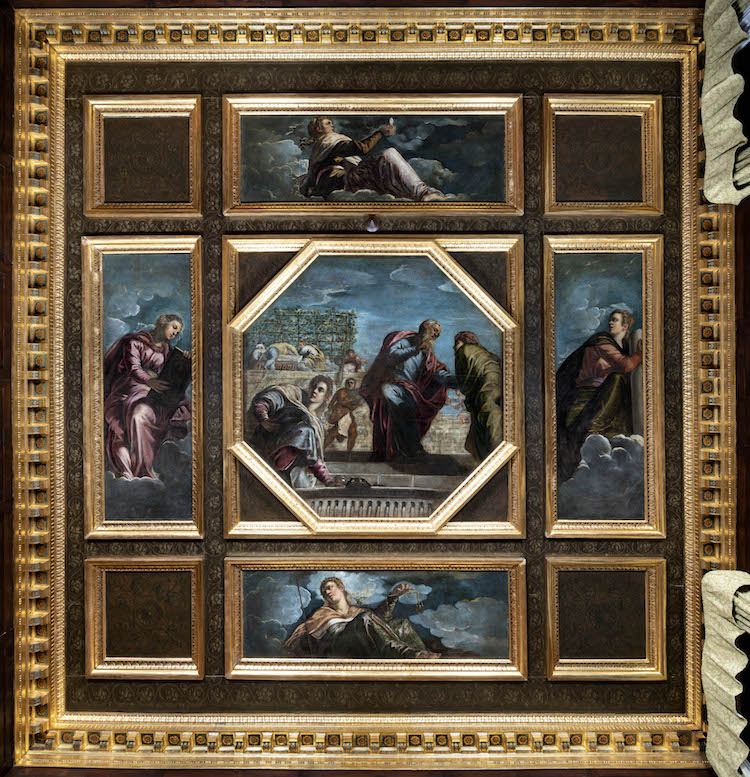The beautiful Doge’s Palace in Venice is currently hosting a very special exhibition featuring the works of Renaissance genius Tintoretto, which runs until next January
“I never was so utterly crushed to the earth before any human intellect as I was today, before Tintoret”, wrote Ruskin to his father, after having visited the Scuola Grande di San Rocco. “As for painting,” continued the nineteenth-century critic, “I think I didn’t know what it meant until today — the fellow outlines you your figure with ten strokes, and colours it with as many more. I don’t believe it took him ten minutes to invent and paint a whole length. Away he goes, heaping host on host, multitudes that no man can number — never pausing, never repeating himself — clouds, and whirlwinds and fire and infinity of earth and sea, all alike to him”.
The most Venetian of the Renaissance artists, the one who most “marked” Venice with the unmistakable mark of his genius – called upon by doges and notables to beautify the city’s palaces and churches – Tintoretto has been able to amaze and impress entire generations of art lovers. He astonished his contemporaries, impressed El Greco, Rubens and Velasquez, anticipated in many ways the sensibility of contemporary artists and now, 500 years after his birth, returns to fascinate the public on the occasion of the celebrations that all Venice is dedicating to him, running until January 2019.

The focal point is the impressive exhibition that Fondazione Musei Civici di Venezia has been working on since 2015 with the National Gallery of Art in Washington and that has enjoyed the full collaboration of the Gallerie dell’Accademia di Venezia. The result, eighty years aer the last exhibition dedicated to him in the city, is an extraordinary monographic exhibition about the artist in the Doge’s Palace from 7 September 2018 to 6 January 2019 (TINTORETTO 1519 – 1594), which focuses on the most fruitful period of his art – from his full affirmation around the mid-1540s to his last works – accompanied by a further major exhibition at the same time at the Gallerie dell’Accademia di Venezia (THE YOUNG TINTORETTO), dedicated to the masterpieces of the first decade of his activity and to the fertile context in which he began his artistic career. From 10 March 2019, it will be the National Gallery of Art in Washington to offer the figure and the art of Tintoretto in its complexity for the first time in the United States, in a show of excellence based on the group of works displayed in the exhibition in the Doge’s Palace.
Many prestigious institutions in Venice will be celebrating Jacopo Robusti with original exhibitions, publishing and conference initiatives in this special year, in a collaborative spirit and in a network advocated and supported by the Mayor of Venice, Luigi Brugnaro. Among these, in particular, are the Scuola Grande di San Rocco, one of the key sites of the master’s activity and home to imposing pictorial cycles, and the Patriarchal Curia, with the many churches that still conserve precious works by Tintoretto. The support of Save Venice Inc. has been fundamental: in these two years, it has supported the scientific examination and restoration of many masterpieces by the artist present in Venice (no less than eighteen paintings and the artist’s tomb), enabling the public to admire them in their splendour within the exhibitions or in the city itinerary specially planned by the Fondazione Musei Civici di Venezia in collaboration with the Patriarchal Curia.

In the magnificent rooms of the Doge’s Apartment in the Doge’s Palace – the place that most testifies to the success and dominance achieved by Jacopo in the sixteenth-century Venetian art scene, despite the presence of such giants and competitors (!) as Titian and Veronese – Tintoretto returns as the protagonist in a major exhibition, strongly backed by the Fondazione Musei Civici di Venezia and by its director Gabriella Belli, promoted jointly with the National Gallery of Art in Washington, with the collaboration of the Gallerie dell’Accademia di Venezia, the contribution of Save Venice Inc. and the support of Louis Vuitton.
The curators of the exhibitions both at the Doge’s Palace and in Washington, are two American scholars, great connoisseurs of Tintoretto – Robert Echols and Frederick Ilchman – who for years have concentrated their research on drawing up a catalogue raisonné of Jacopo’s work. Alongside them, on this occasion, there will be a prestigious international advisory committee and numerous experts of Venetian Renaissance art, who are contributing with essays in the catalogue of the two exhibitions, published by Marsilio: Stefania Mason, Roland Krischel, Susannah Rutherglen, Mattia Biffis, Peter Humfrey, Lorenzo Buonanno, Michiaki Koshikawa, Miguel Falomir, Maria Agnese Chiari Moretto and Giorgio Tagliaferro.
The most recent studies and the illuminating restorations of the last two decades have allowed a rigorous analysis of the paintings and their chronology: among these in particular are the interventions undertaken by Save Venice Inc. which have also enabled the scientific examination and restoration of some works in the Museo Correr and of the extraordinary paintings of the Anticollegio, Atrio Quadrato and Sala degli Inquisitori in the Doge’s Palace, which can finally be admired in their complete expressive power.
With fifty autograph paintings and twenty drawings by Tintoretto, lent by the great international museums, together with the famous cycles painted for the Doge’s palace between 1564 and 1592 – visible in their original position – the exhibition will showcase all the visionary, bold and wholly unconventional painting of Jacopo Robusti. The son of a dyer, “like a single peppercorn capable of overcoming ten bunches of poppy” as his playwright friend Andrea Calmo described him, Tintoretto knew how to challenge the tradition embodied by Titian, overwhelming it and choosing to innovate: not only with daring technical and stylistic solutions, but also with iconographic experiments that marked a turning point in the history of Venetian painting of the sixteenth century.
An extraordinary storyteller, skilled director of painted actions, and sophisticated colourist – he who used the full range of pigments available in the Venice of his time – Tintoretto reveals himself as a fascinating interpreter in all the different genres he explored, from religious subjects to great history paintings, and from portraiture to profane and mythological themes, of which the exhibition offers illuminating examples thanks to loans from important museums all over the world and from some prestigious private collections: from the museums of London – such as the National Gallery from which arrives The Origin of the Milky Way (1575), the Royal Collection, the Victoria and Albert Museum, the Courtauld Gallery – but also of Paris, Ghent, Lyon, Dresden, Otterlo, Prague and Rotterdam.

The Prado of Madrid has loaned five extraordinary works, including Joseph and the wife of Potiphar (circa 1555), Judith and Holofernes (1552-1555) and The Rape of Helena (1578), over three metres long, painted for the court of the Gonzagas, whose great quality can now be appreciated.
Susanna and the Elders of 1577, among Jacopo’s most famous masterpieces, comes from the Kunsthistorisches Museum in Vienna and, thanks to the Staatliche Museen of Berlin, visitors will be able to admire the nobility of the Portrait of Giovanni Mocenigo (1580) which, included in a wide-ranging gallery of portraits, reveals to us how Tintoretto, in spite of what the critics believed at one time, was also a skilled interpreter of human psychology.
The two self-portraits with which the exhibition opens and closes are emblematic and revealing; one was painted at the beginning and one at the end of Jacopo’s career and are being loaned respectively by the Philadelphia Museum of Art and the Musée du Louvre.
In particular, in the youthful portrait executed around 1546/47, defined by the curators as the first “autonomous” self-portrait in European art, we can already sense the strength of personality, the ambition and the energy of painting that would connote the whole of Tintoretto’s career, but also the absolute novelty of his restless and sometimes mysterious art, with forceful brushstrokes interrupted by highlights of clumps of paint and that sought-aer sense of the unfinished.
Among the religious masterpieces, a renewed quality stands out, revealed by the recent restorations, of the altarpieces of San Marziale and of the Ateneo Veneto which today appear among the most interesting works of the master. And likewise for the large canvases of his last years, in which the hand of his son Domenico and of his workshop can be discerned, but which preserve intact the whole visionary approach of the great Tintoretto in the conception of the composition.
“It seemed to me I had advanced to the uttermost limit of painting”, wrote Henry James after seeing Tintoretto’s paintings in San Cassiano, “that beyond this another art – inspired poetry – begins, and that Bellini, Veronese, Giorgione, and Titian, all joining hands and straining every muscle of their genius, reach forward not so far but that they leave a visible space in which Tintoret alone is master […]. No painter ever had such breadth and such depth…Titian was assuredly a mighty poet, but Tintoret, well, Tintoret was almost a prophet.”
![]()
All images courtesy Tintoretto 500
- Lead image kroellermueller-NGA Londra in primo piano
- Il doge Gerolamo Priuli accompagnato da San Gerolamo davanti a Pace e Giustizia, 1562-65
- Il ritorno del figliol prodigo (al centro) – La Fe…la Legge, la Giustizia, la Concordia (ai lati)


Leave a Reply